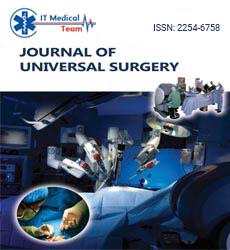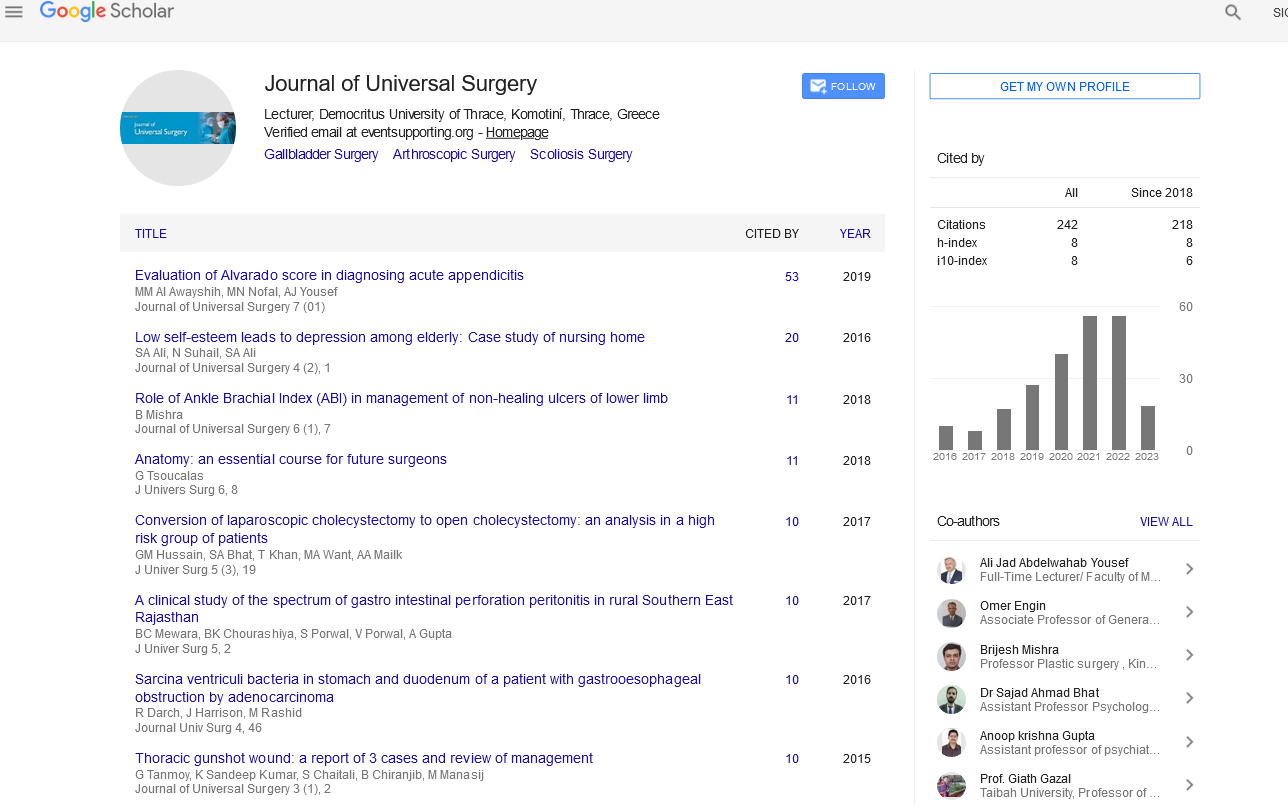Review - (2023) Volume 11, Issue 4
Spontaneous coronary dissection: Optical coherence tomography “Live Flash” Angioplasty Guide
Jones Alice*
Hospital do Espirito Santo, Largo Senhor da Pobreza, 7000-811 Évora, Portugal
*Correspondence:
Jones Alice, Hospital do Espirito Santo, Largo Senhor da Pobreza, 7000-811 Évora,
Portugal,
Email:
Received: 03-Apr-2023, Manuscript No. IPJUS-23-13577;
Editor assigned: 05-Apr-2023, Pre QC No. P-13577;
Reviewed: 19-Apr-2023, QC No. Q-13577;
Revised: 21-Apr-2023, Manuscript No. R-13577;
Published:
28-Apr-2023
Abstract
Optical coherence tomography (OCT) is a light-based imaging modality
with great potential in coronary imaging. Spontaneous coronary artery
dissection (SCAD) is a rare cause of acute coronary syndrome (ACS). The
diagnosis of SCAD is made primarily by invasive coronary angiography,
although additional imaging modalities such as CT angiography, IVUS,
and OCT may enhance the diagnostic outcome. The authors describe
the clinical case of a young woman hospitalized with a diagnosis of
SCA. SCA-induced SCAD was detected in coronary angiography and
OCT-guided angioplasty. The use of OCT in the context of SCAD has
been described and the real innovation in this case is this unique use of
OCT. Short and direct visual angioplasty guidance is very useful because
it allows the location of the guide wires to be clearly determined at
all times without the need for a large amount of contrast medium.
Optical coherence tomography (OCT) is a light-based imaging modality
with great potential in coronary imaging. Compared with intravascular
ultrasound (IVUS), OCT has ten times the image resolution. It has the
ability to describe the structure and extent of coronary artery disease in
unprecedented detail because different components of atherosclerotic
plaque have different properties. In everyday practice, OCT is useful to
guide complex interventions. Image acquisition has some peculiarities
because the blood must be moved during the OCT scan. In fact, OCT
images are obtained and recorded when the coronary artery is flushed
with contrast and the imaging tip of the catheter is withdrawn.
Keywords
Hip surgery; Hydrocele surgery; Hysterectomy surgery;
Implants surgery; Laparoscopic surgery; Minimally invasive surgery
INTRODUCTION
Spontaneous coronary artery dissection (SCAD) is a rare
cause of acute coronary syndrome (ACS) that usually
affects young, healthy individuals. The population-based
incidence of SCAD is unknown. Retrospective registry
studies have reported detection of SCAD in 0.07% to
1.1% of all coronary angiograms performed. There is
clearly a female predominance and an association with
perinatal or postnatal status. Other identified SCAD
associations include connective tissue disorders, vasculitis,
polycystic kidney disease, and exercise, suggesting an
underlying vascular predisposition in some individuals,
despite systemic structural abnormalities most of the vessel
wall has not been determined [1]. Diagnosis of SCAD is
primarily based on invasive coronary angiography, although
additional imaging modalities such as CT angiography,
IVUS, and OCT may enhance the diagnostic outcome
[2]. OCT provides unique insights into the most relevant
morphological features of the disease, including entrance
laceration, endothelium flap, double lumen morphology,
intramural hematoma, and associated thrombosis [3]. The
optimal therapeutic strategy for acute SCAD expression
has yet to be determined and may vary depending on
the type and severity of the manifestation. Reports have
demonstrated favorable outcomes with conservative
management (with documented angiographic resolution),
fibrinolysis, percutaneous coronary intervention (PCI),
and coronary artery bypass grafting (CABG) [4].
Regardless of the initial treatment strategy, in-hospital
and initial outcomes are generally reported to be favorable
[5]. A 41-year-old obese woman with polycystic kidney
disease was referred to the catheterization department after
an episode of chest pain with troponin elevation 1 week
after primary PCI due to an acute ST-segment elevation
myocardial infarction. Simultaneous angiography showed
balanced dominant circulation, with TIMI 3 flow in the
right coronary artery (RCA) without stenosis and sub
obstructive lesions in the small posterior lateral branch
(PLB) of the circumflex artery [6]. Is considered to be
injurious [7].
DISCUSSION
Balloon angioplasty was performed with good results and
TIMI 3 flow. Spontaneous dissection was suspected due
to the presence of opacities at the site of occlusion and
the disappearance of some acute lesions. Marginal branch
compared to the previous examination [8]. We then decided
to perform an OCT (Terumo Longwave® OFDI system) which clearly showed the dual luminous flux morphology
and the conductor was also in the pseudo luminescence [9].
We then performed angioplasty under the control of OCT
[10]. With the live OCT images, which did not record any
actual shrinkage, we used small contrasting clusters until we
could confirm that the guide was on real light and. OCT
was also able to very clearly identify the entrance tear. After
the true lumen was protected, we performed angioplasty
with a drug-eluting stent to seal the tear at the entrance of
the proximal right coronary artery. There is a final TIMI
3 outflow, and the acute marginal branches are visible
again, but there is narrowing in the distal vessel where the
false lumen is still visible but with signs of thrombosis. To
avoid making an all-metal jacket, we decided to accept
the results and perform a follow-up angiogram a month
later. After a peaceful month, follow-up angiography
showed persistence of a large dissection extending to the
distal vessel. There is a significant trade-off between true
light and false light. Considering the previous STEMI
presentation and negative angiography within one month,
we performed an OCT that confirmed the dissection and
showed that the conductor was now in the true lumen In
this context, we decided to seal the incision by implanting
two additional drug-eluting stents into the medial and
distal RCA to ensure long-term patency of the vessel (Figure
8). The dissection remains at a very far distance, which is
a small ship. The diagnosis and management of SCAD is
very difficult. However, an accurate and early diagnosis is
still essential. There are limited data regarding the use and
interest of OCT in this rare disease. In the case cited above,
the OCT could easily visualize the characteristic double
lumen morphology of this entity and identify the entry tear
as well as the circumferential nature and extent of disease.
The trade-off between the true luminous flux distribution
and the spurious luminous flux is also clearly visualized.
CONCLUSION
The low profile (catheter cross profile: 2.6 Fr) and higher
resolution of the OCT are useful in this case as it allows
the image to be obtained. High quality images of long
arterial segments. However, OCT is not without potential
risks. In the SCAD situation, it may further spread
dissection and/or tear of the endometrium, due to the
rapid change in coronary flow, so its use must be weighed
against the potential benefits. Compared with the potential
harm. A careful rate of contrast injection is of the utmost
importance. In this case, OCT proved to be particularly
useful, as it not only allowed precise identification of
dissections and tears of the endothelium, but also made
it possible to precisely wire real light, with direct imaging.
continue during wire manipulation with a fixed device.
OCT catheter. The usefulness of OCT in the context of
SCAD has been reported, and the technique we describe
in this case represents an innovation that may become
more interesting in the future, with the technical evolution
of OCT. This technique opens up a promising field of
software development; For example, we believe it would
be helpful to be able to capture images with a fixed OCT
catheter and not just those obtained during automated
removal with complete coronary artery lavage. Another
potential advantage of this technique (OCT) in the SCAD
context is the ability to perform 3D OCT online to
improve input tear identification. For the angioplasty itself,
we will use biodegradable scaffolds, if they are available in
our catheterization room at the time of this procedure. In
a more detailed analysis of the OCT images after the final
procedure, we found that the entrance tear was posterior to
the distal part of the previously implanted stent. Now we
are wondering if we can seal the incision with just a balloon
after dilation.
REFERENCES
- Wilkoff BL, Cook JR, Epstein AE, et al. Dual-chamber pacing or ventricular backup pacing in patients with an implantable defibrillator: the Dual Chamber and VVI Implantable Defibrillator (DAVID) Trial. JAMA. 2002; 288: 3115-23.
Indexed at, Google Scholar, Crossref
- Pena Rafael E, Shepard Richard K, Ellenbogen Kenneth A, et al. How to make a submuscular pocket. J Cardiovasc Electrophysiol. 2006; 17: 1381-1383.
Indexed at, Google Scholar, Crossref
- Marco D, Eisinger G, Hayes DL, et al. Testing of work environments for electromagnetic interference. Pacing Clin Electrophysiol. 1992; 15: 2016-22.
Indexed at, Google Scholar, Crossref
- Ferreira António M, Costa Francisco, Marques Hugo, et al. MRI-conditional pacemakers: current perspectives. Med Devices: Evid Res. 2014; 7: 115-124.
Indexed at, Google Scholar, Crossref
- Dean Meara, Ramsay Robert, Heriot Alexander, et al. Warmed, humidified CO2 insufflation benefits intraoperative core temperature during laparoscopic surgery: A meta-analysis. Asian J Endosc Surg. 2017; 10: 128-136.
Indexed at, Google Scholar, Crossref
- Ma Y, Yang Z, Qin H, et al. A meta-analysis of laparoscopy compared with open colorectal resection for colorectal cancer. Medical Oncology. 2011; 28: 925-933.
Indexed at, Google Scholar, Cross ref
- Semm K. Endoscopic appendectomy. Endoscopy. 1983; 15: 59-64.
Indexed at, Google Scholar, Cross ref
- Katz Aviva L, Webb Sally A, Macauley, et al. Informed Consent in Decision-Making in Pediatric Practice. Pediatrics. 2016; 138: 14-85.
Indexed at, Google Scholar, Crossref
- Mazur Kate A, Berg Stacey L. Ethical Issues in Pediatric Hematology. Oncology. 2020; 13-21.
Indexed at, Google Scholar, Crossref
- Stern, Alexandra Minna, Markel Howard. Formative Years: Children's Health in the United States, 1880-2000. UMHS. 2002; 23-24.
Indexed at, Google Scholar, Crossref





